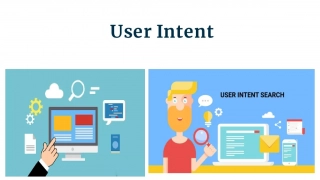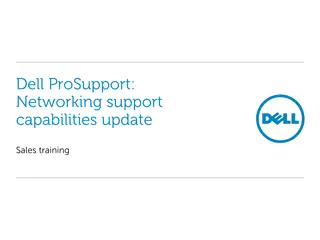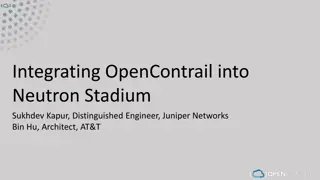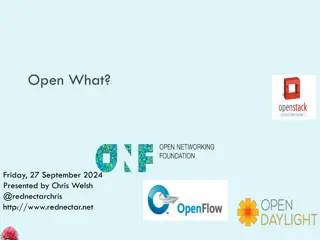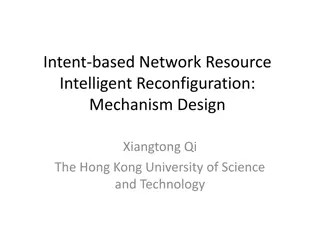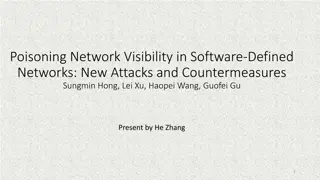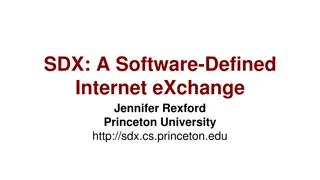Revolutionizing Network Management with Intent-Based Networking
Explore the concept and benefits of Intent-Based Networking (IBN) in simplifying network configuration and enhancing efficiency. Learn how IBN automates network operations, aligns with business objectives, improves security, and ensures scalability and reliability. Discover the potential of IBN tools in revolutionizing network management practices for a more agile and responsive network infrastructure.
Download Presentation

Please find below an Image/Link to download the presentation.
The content on the website is provided AS IS for your information and personal use only. It may not be sold, licensed, or shared on other websites without obtaining consent from the author. Download presentation by click this link. If you encounter any issues during the download, it is possible that the publisher has removed the file from their server.
E N D
Presentation Transcript
Development of an IBN tool for Network Automation Presenter: Mohit Rai (CE, mr06638) Proposed Advisor: Dr.Farhan Khan Proposed External Advisor: Dr. Faraz Haider
Introduction Have you ever wondered how to simplify these complex network configuration and make network management more efficient? The answer to this question lies in a higher level of Network Automation. Generally, it implement alerts, triggers and remediation on events .In addition to that it will also be beneficial in streamlining workflows, optimizing resources and enhancing security. Hence, I am are here today to discuss my project which is an attempt to revolutionize Network Management using IBN or Intent-Based Networking The basic Intent, as the name goes, here is to introduce the concept of Intent- based Networking, address the problems in traditional networking, convey the ways in which IBN is potentially better than existing solutions and outline my plan to develop an IBN tool
Problem Statement Networking has traditionally been driven by manual, command-line interface (CLI)-based operations, fundamental element management systems (EMSs), or automated scripts. The majority of network disruptions are caused by human error during these network activities. As the Network Grows and evolves, there is a pressing need for simplifying the network management, automating network configuration and aligning the Network operations with business Intents. Problem Statement: To address the problem of human errors in Network Configurations, there is a strong need to fully automate the configuration process by developing a tool which can translate Network Intents written in English leading to Generation of Vendor Specific Network Configurations .
What is IBN? Intent-based networking (IBN) is a sophisticated approach to network automation that leverages intelligence and analytics. It translates high-level business objectives into network configurations without manual coding, simplifying operations. For instance, it can automatically create secure tunnels between networks based on broad intent descriptions. IBN potentially also continuously validates network correctness, ensuring configurations align with intentions, enhancing network uptime and reliability. IBN operates on a declarative network model, in contrast to traditional imperative networking. In traditional networking, engineers specify sequential actions for each network element, leading to error-prone configurations. IBN eliminates this complexity by abstracting the configuration process, making network management more efficient, agile, and aligned with an organization's strategic goals.
Why IBN? Stakeholders Simplification: IBN simplifies network management, automating complex configurations and reducing errors for enhanced efficiency. Alignment: It aligns the network with business objectives, improving agility, scalability, and responsiveness to changing needs. Security: IBN enhances security with automated policy enforcement and real-time threat detection. Efficiency: Efficient resource utilization, reduced downtime, and vendor flexibility contribute to cost savings and reliability. Scalability: IBN automates resource scaling, ensuring the network can handle increased traffic and devices effectively. Reliability: Continuous validation minimizes network downtime, leading to improved network reliability. Flexibility: It promotes vendor interoperability and abstraction, allowing organizations to choose the most suitable network components. Agility: Rapid adaptation to changing business requirements is enabled by IBN, facilitating faster deployment and market responsiveness. Network Administrators: These professionals are directly affected by the problem as they struggle with complex configurations, leading to errors and inefficiencies in network management. Business Leadership: Efficient network management is crucial for business leaders to achieve cost reduction, agility, and alignment with strategic goals. End-Users: Employees and customers depend on a reliable network for productivity and the delivery of services, making them key stakeholders. Network Service Providers: Efficient network management tools are essential for service providers to deliver high-quality services and maintain competitiveness. Network Security Teams: Security teams require a well-managed network to protect against cyber threats and ensure compliance, reducing the risk of breaches.
Market statistics: The Intent-based networking Market is expected to reach about 8.4 Billion USD by 2032, up from 1.2 billion in 2022, as per the survey conducted by [1] The compound annual growth rate or CAGR of the Intent-based networks is expected to reach 30% by 2028, as displayed in [2] As per [1], the leading sector, which will adopt the IBN networking technology will be the Banking and Financial or BFSI sector. Major technological Companies invested in Intent-based networking: Cisco, Juniper Networks, IBM, Huawei, Nokia, Vmware, Apstra, NetBrain Technologies, Indeni, ONF Impact on other industries: The impact of IBN would not be limited to just the wired Industry, but it would would also include the wireless or 5G/6G , as the literature survey [1] highlights the different IBN solutions available in the domain of 6G, which also shows that how much companies such as Cisco, Juniper Networks, Huawei and Spruce are invested in this domain
How does IBN compare with existing solutions? IBN is superior to SDN and NFV in the following ways: It is more scalable. IBN can be used to manage large and complex networks, while SDN and NFV are better suited for smaller networks. It is more flexible. IBN allows network administrators to define their intent in a variety of ways, while SDN and NFV are more limited in their capabilities. It is more secure. IBN can be used to enforce security policies across the entire network, while SDN and NFV are more focused on individual network devices. The SDN controller can be used to enforce policies that are defined in terms of business intent (working with IBN) The NFV infrastructure can be used to host network functions that are required to enforce these policies. (working with IBN) The SDN controller can be used to collect telemetry data from the network infrastructure, which can be used to improve the performance of the network.(working with IBN) The NFV infrastructure can be used to host analytics applications that can be used to analyze telemetry data.(working with IBN)
Intent Profiling Template based/ GUI-based approach: This technique uses templates or graphical user interfaces (GUIs) to help users define their intents. This approach is easy to use, but it can be inflexible and difficult to scale. NLP (Natural-Language Processing based approach): This technique uses natural language processing (NLP) to extract intents from text or speech. This approach is more powerful than template-based approaches, but it can be more complex and difficult to implement. Intent-based languages: This technique uses a dedicated language to express intents. This approach is very flexible and powerful, but it can be difficult to learn and use. API Intent Expression: This technique uses application programming interfaces (APIs) to express intents. This approach is easy to use, but it can be less flexible than other approaches. Grammar/Keyword-Based: This technique uses grammars or keywords to extract intents from text or speech. This approach is easy to use and implement, but it can be less accurate than other approaches.
Deliverables Approach 1. Research and Analysis: Conduct extensive research and analysis of Intent-Based Networking (IBN) concepts, existing technologies, and best practices. Tool Development: Develop the IBN-based tool, ensuring it aligns with research findings and requirements. Use-Case Implementation: Implement practical use-cases to validate the tool's functionality and performance. Documentation: Document the entire project, including research, development, implementation, and testing phases. Presentation and Publication (Optional): Present findings to the academic community and publish research papers in relevant conferences and journals. 1. IBN-Based Tool: The primary deliverable will be a functional Intent-Based Networking (IBN) tool implemented Fully Configured Topology Diagrams:The Diagrams would be configured with the configuration generated by the IBN tool. Use-Cases with Configuration Scripts: Practical use-case scenarios, such as SD- WAN systems and secure VPN connections, will be implemented and accompanied by configuration scripts for verification. Conference and Journal Papers (Optional): Research findings and project outcomes will be documented in research papers suitable for submission to conferences and journals in the field. 2. 2. 3. 3. 4. 4. 5.
References Market Research: [1]https://www.marketresearchfuture.com/reports/intent-based-networking-market-6846 [2]https://www.digitaljournal.com/pr/intent-based-networking-ibn-market-scope-and-overview-to-develop-with-increased-global-emphasis- on-industrialization-2029-cisco-systems-huawei-technologies-fortinet Research Articles: A. Leivadeas and M. Falkner, "A Survey on Intent-Based Networking," in IEEE Communications Surveys & Tutorials, vol. 25, no. 1, pp. 625- 655, Firstquarter 2023, doi: 10.1109/COMST.2022.3215919. Wei, Yiming & Peng, Mugen & Liu, Yaqiong. (2020). Intent-based networks for 6G: Insights and challenges. Digital Communications and Networks. 6. 10.1016/j.dcan.2020.07.001. Kashif Mehmood, Katina Kralevska, and David Palma. 2023. Intent-driven autonomous network and service management in future cellular networks: A structured literature review. Comput. Netw. 220, C (Jan 2023). https://doi.org/10.1016/j.comnet.2022.109477 Websites: https://www.juniper.net/us/en/research-topics/what-is-intent-based-networking.html#:~:text=based%20networking%20FAQs- ,What%20problems%20does%20intent%2Dbased%20networking%20solve%3F,manual%2C%20CLI%2Ddriven%20operations. https://www.linkedin.com/pulse/article-3-navigating-future-intent-based-networking-empowering/



